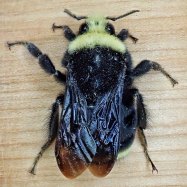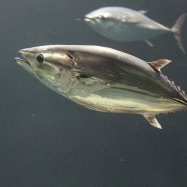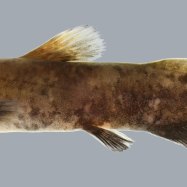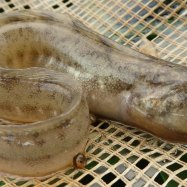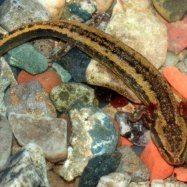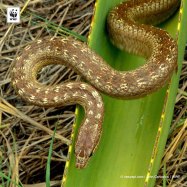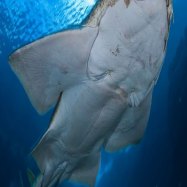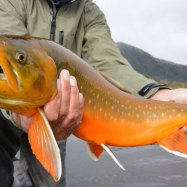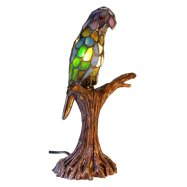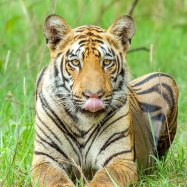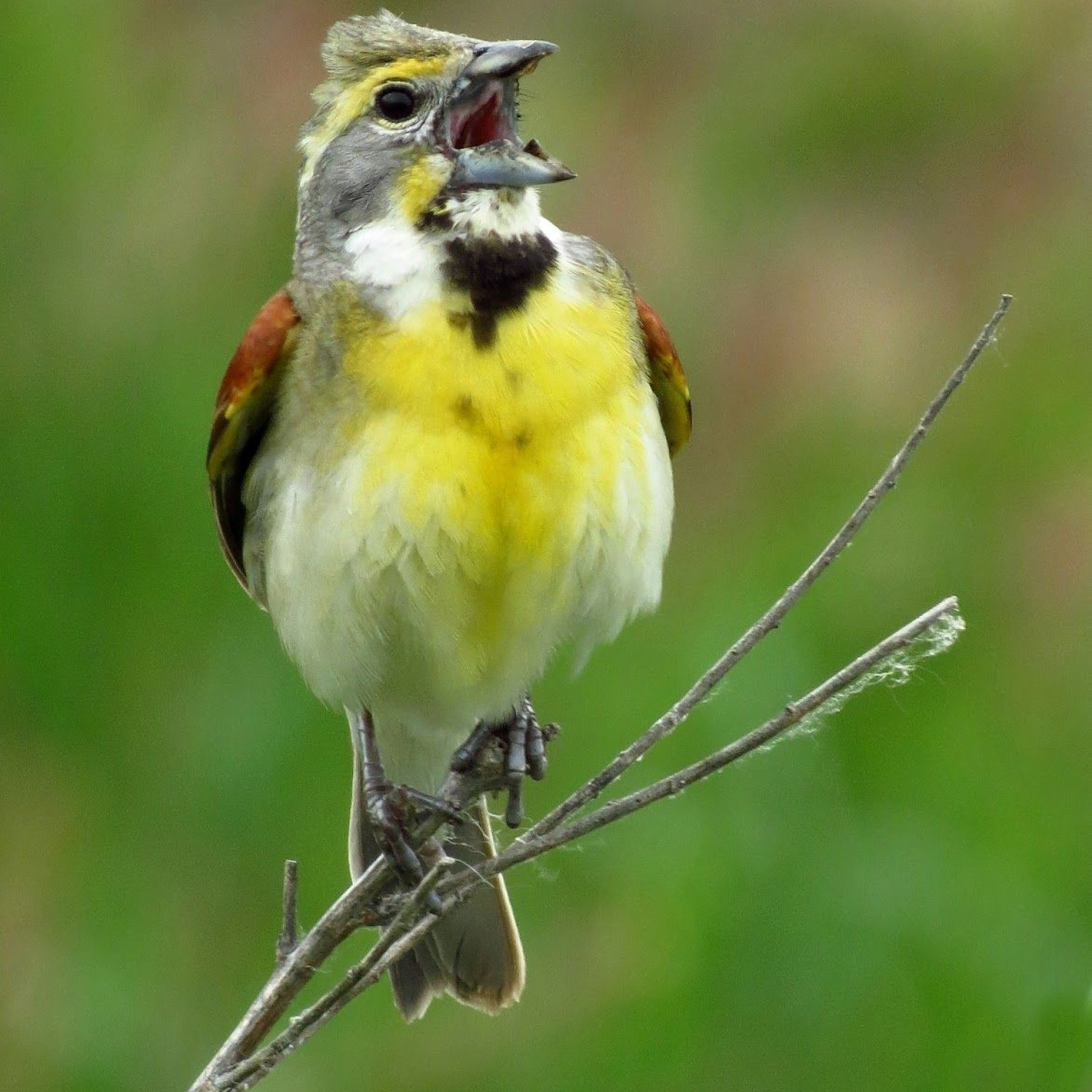
Dickcissel
14-17 cm
The Dickcissel, a small and stocky bird with a medium-length tail, is a member of the Cardinalidae family. It can be found in the tallgrass prairies of central United States, and can grow up to 14-17 cm in length. With its distinctive yellow chest and black bib, it is a treat for birdwatchers and nature enthusiasts alike. Keep an eye out for this colorful and charming bird on your next hike in the prairies. #Dickcissel #birds #naturelovers
Animal Details Summary:
Common Name: Dickcissel
Kingdom: Animalia
Habitat: Grasslands, prairies, fields
A Songbird of the Prairies: The Fascinating Dickcissel
The prairies of North and Central America are abundant with an array of beautiful and fascinating bird species. Among them is the Dickcissel, a small but vocal songbird with eye-catching colors and a unique song that has perplexed ornithologists for years.Scientifically known as Spiza americana, the Dickcissel belongs to the kingdom Animalia, making it an important part of the diverse animal kingdom. It is a member of the Phylum Chordata, Class Aves, and Order Passeriformes, and is a part of the Cardinalidae family, which includes cardinals, grosbeaks, and buntings Dickcissel.
The name "Dickcissel" is believed to have originated from the bird's distinctive call - a sharp "dick, dick, ciss, ciss" sound that can often be heard throughout its habitat.
Habitat and Distribution
The Dickcissel is primarily found in grasslands, prairies, and fields, preferring habitats with tall, thick grasses and a mix of open areas for foraging. They are abundant in the central United States, particularly in the tallgrass prairies, but can also be found in parts of Canada and Mexico.Dickcissels are highly migratory birds, with their breeding range spanning from the southern parts of Canada to northern Mexico. During the winter, they migrate southwards to Colombia, Venezuela, and the northern regions of Argentina.
Feeding and Diet
While the Dickcissel is mainly herbivorous, their diet is diverse and also includes insects. Their primary source of food consists of seeds, particularly those of grasses, weeds, and crops like sunflower, soybean, and corn. Insects such as grasshoppers, beetles, and caterpillars also make up a significant portion of their diet, especially during the breeding season when they need the extra protein for raising their young.One interesting adaptation of the Dickcissel is its slightly conical-shaped bill, which is ideal for cracking open tough seeds Dinopithecus. They are also able to pluck insects from hidden spots in the grass with their bill.
One of the most fascinating qualities of the Dickcissel is its feeding behavior. Unlike many other birds that forage alone or in small groups, Dickcissels are often seen foraging in large flocks, especially during the non-breeding season. This behavior is believed to have evolved as a defense against predators, as larger groups provide better protection and the ability to spot predators easier.
Physical Characteristics
The Dickcissel is a small, stocky bird with a body length ranging between 14-17 cm and a wingspan of about 25 cm. They have a medium-length tail and a short, thick neck.Males and females have distinctive coloration, making it easy to differentiate between the sexes. Males have striking and vibrant yellow underparts, gray-brown upperparts, and a black bib on their throat and upper chest. The contrast of these colors makes the male Dickcissel a sight to behold. On the other hand, females are more subdued, with brownish tones on their feathers. Juvenile Dickcissels resemble females but have more mottled brown feathers.
The Mysterious Song of the Dickcissel
One of the most intriguing aspects of the Dickcissel is its unique and complex song, which is composed of various phrases and sounds. The male Dickcissel sings its song from an exposed perch on top of a tall grass or shrub, making it easier for others to hear its distinctive call.Ornithologists have long studied the Dickcissel's song, trying to understand its purpose and meaning. One popular theory suggests that the song is a way for male Dickcissels to attract a mate and establish their territory. However, the full complexity and purpose of the song are still not fully understood.
Conservation Status
Despite being a widespread and abundant species, the Dickcissel is facing various threats that have led to a decline in their population. Loss of grassland habitats due to agriculture, urbanization, and other human activities has significantly impacted the Dickcissel's population. They are also susceptible to pesticide use, collisions with buildings and cars, and predation by domestic and feral cats.Conservation efforts are being made to protect their habitats and raise awareness about their importance in maintaining the health of grassland ecosystems. Organizations like the National Audubon Society are actively working towards the conservation of the Dickcissel and other grassland birds.
Interactions with Humans and Captivity
The Dickcissel's beautiful song and striking colors have made it a popular subject for birdwatchers and photographers. They are also occasionally kept as pets, although they are not as common as other pet bird species. Some individuals have even learned to mimic the Dickcissel's call, adding to its charm.In captivity, the Dickcissel requires a large aviary with plenty of space to fly and forage. They also need a varied diet of seeds and insects. It is essential to note that keeping any wild bird species as a pet requires proper permits and should only be done by those who can provide the necessary care.
In Summary
The Dickcissel is a fascinating and integral part of the grassland ecosystems of North and Central America. From its striking colors and unique song to its important role in maintaining the balance of the environment, this small songbird has captivated humans for centuries.While it may face challenges, the Dickcissel continues to thrive and bring joy to those who are lucky enough to spot one in the wild. Let us work towards protecting its habitat and ensuring that future generations can also witness the beauty of this amazing bird.

Dickcissel
Animal Details Dickcissel - Scientific Name: Spiza americana
- Category: Animals D
- Scientific Name: Spiza americana
- Common Name: Dickcissel
- Kingdom: Animalia
- Phylum: Chordata
- Class: Aves
- Order: Passeriformes
- Family: Cardinalidae
- Habitat: Grasslands, prairies, fields
- Feeding Method: Mainly herbivorous, feeds on seeds and insects
- Geographical Distribution: North and Central America
- Country of Origin: United States
- Location: Preferentially found in tallgrass prairies of the central United States
- Animal Coloration: Males have yellow underparts, gray-brown upperparts, and a black bib; females are more subdued with brownish tones
- Body Shape: Small, stocky bird with a medium-length tail
- Length: 14-17 cm
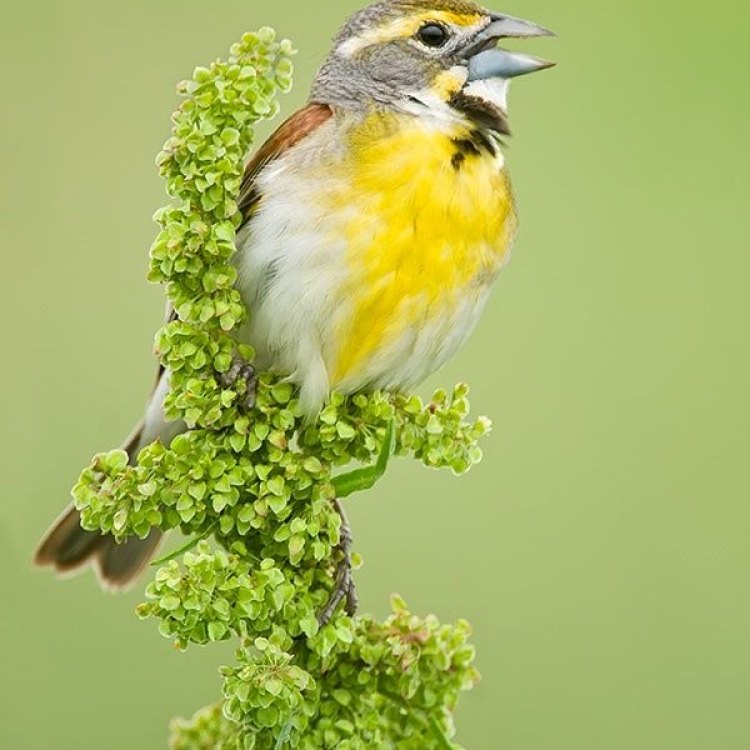
Dickcissel
- Adult Size: Small
- Average Lifespan: 3-5 years
- Reproduction: Open cup nest
- Reproductive Behavior: Monogamous
- Sound or Call: Distinctive buzzing song
- Migration Pattern: Migratory, spend winters in southern Mexico and Central America
- Social Groups: Solitary or in small groups during migration
- Behavior: Often perches on tall grasses and sings from open perches
- Threats: Loss of grassland habitat, pesticide use
- Conservation Status: Least Concern
- Impact on Ecosystem: Important for seed dispersal and insect control
- Human Use: Game bird, occasionally kept as a cage bird
- Distinctive Features: Black bib on males, yellow underparts, distinctive song
- Interesting Facts: The Dickcissel gets its name from its distinctive song, which sounds like 'dick dick ciss ciss'
- Predator: Birds of prey, snakes, and small mammals
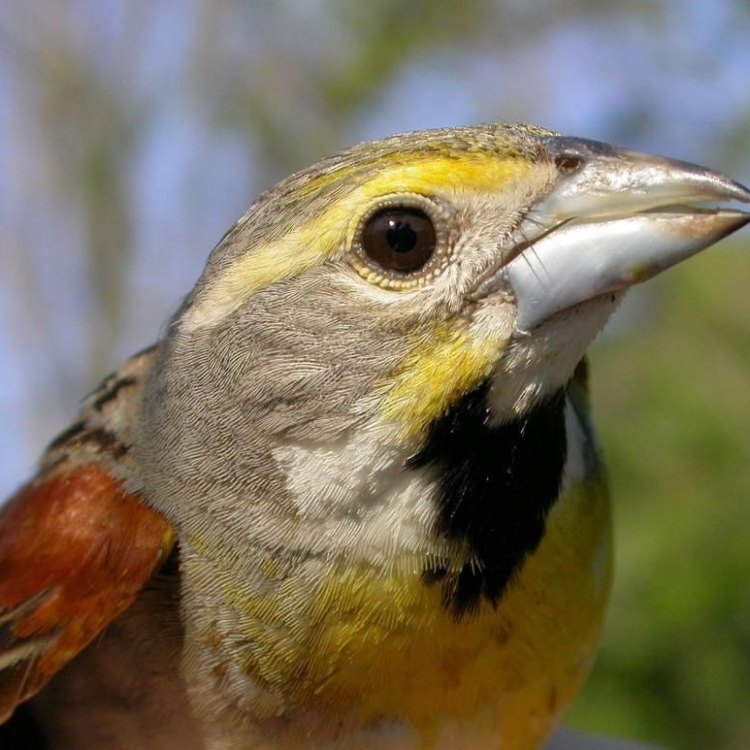
Spiza americana
Dickcissel: The Colorful Grassland Songbird That is More Than Just a Pretty Face
In the vast grasslands of North America, there is a small, but mighty songbird that is often overlooked – the Dickcissel. With its bright yellow plumage, striking black bib, and unique buzzing song, the Dickcissel is a bird that deserves our attention. In this article, we will explore the fascinating details of this tiny bird, from its size and behavior to its impact on the ecosystem and its relationship with humans.Size and Lifespan
The Dickcissel is a small bird, with an adult size ranging from 5-6 inches in length and a wingspan of 7-8 inches PeaceOfAnimals.Com. They weigh between 0.5-1 ounce, making them one of the smallest songbirds in North America. Their small size allows them to thrive in the open grasslands, where they can easily hide in the tall grasses.In terms of lifespan, the Dickcissel has an average lifespan of 3-5 years. However, in some cases, they have been known to live up to 9 years in captivity. This short lifespan is due to various factors such as predators, habitat loss, and human activities.
Reproduction and Behavior
One of the most interesting aspects of the Dickcissel's behavior is its reproductive behavior. They typically build open cup nests in dense grasses, which they line with plant materials and feathers. The female is responsible for building the nest, while the male brings her the materials Dapple Dachshund.Dickcissels are monogamous birds, meaning they have one mate for the breeding season. However, they may choose a new mate each breeding season. Both the male and female take turns incubating the eggs and caring for the young after they hatch.
During the breeding season, male Dickcissels can be quite territorial and will fiercely defend their nesting area. They have a unique courtship ritual where the male flies higher and higher into the sky, singing their distinctive buzzing song, to impress the female.
Once the breeding season is over, Dickcissels become solitary or live in small groups during migration. They are migratory birds, spending their winters in southern Mexico and Central America. In the spring, they return to North America to breed and raise their young.
Distinctive Features and Sounds
Male and female Dickcissels have distinct physical characteristics. Males have a black bib on their throat and chest, while females have a grayish-colored bib. Both have bright yellow underparts and brownish-colored upperparts, making them easy to spot in the grasslands.The Dickcissel also has a distinctive call, which gives it its name. It sounds like "dick dick ciss ciss" and can be heard from a distance. This call is mostly sung by the males, especially during the breeding season, as a way to attract mates and defend their territory.
Threats and Conservation Status
Despite their importance in the ecosystem, the Dickcissel is facing numerous threats. The most significant threat is the loss of grassland habitats due to agriculture and urbanization. As grasslands disappear, so does the Dickcissel's home, leading to a decline in their population.Another threat to the Dickcissel is pesticide use. These birds feed on insects, and pesticides can harm or kill them, disrupting the food chain and impacting their survival. Climate change is also a concern, as it can change the timing of their migration and breeding, affecting their ability to find food and raise their young.
Thankfully, the Dickcissel is currently listed as Least Concern on the IUCN Red List due to its large population and wide range. However, conservation efforts are still needed to prevent their decline and ensure their survival.
Impact on the Ecosystem and Human Use
The Dickcissel may be a small bird, but it plays a crucial role in the grassland ecosystem. They primarily feed on insects, helping to control their populations. They also play a role in seed dispersal, as they often forage on seeds and spread them throughout the grasslands.Humans have also used Dickcissels for various purposes. They were once a popular game bird, but their hunting is now carefully regulated. In some parts of the world, they are also occasionally kept as cage birds due to their beautiful plumage and unique song. However, it is essential to note that they are protected by the Migratory Bird Treaty Act, and it is illegal to keep them as pets without proper permits.
Interesting Facts
The Dickcissel is full of interesting and unique facts. One of the most fascinating is how they got their name. The name "dickcissel" is derived from their distinctive song, which sounds like "dick dick ciss ciss." Their scientific name, Spiza americana, also reflects their American origins, meaning "American Finch."Another interesting fact is that the Dickcissel is closely related to the European Yellowhammer bird. They are so similar that they were once considered the same species. However, further studies determined that they are two distinct species.
Predators
Like any other bird, the Dickcissel has its share of predators. They are primarily preyed upon by birds of prey such as hawks, falcons, and owls. Snakes and small mammals, such as raccoons and skunks, can also pose a threat to their nests and young.With their small size and open habitat, Dickcissels have developed various defensive strategies to avoid predators. They use their camouflage to blend in with the grass, and their flying abilities to escape danger quickly.
In Conclusion
The Dickcissel is a colorful and unique songbird that deserves our attention and conservation efforts. They may be small, but they play a crucial role in the grassland ecosystem and have fascinating behaviors and features that make them stand out. It is essential that we continue to protect their habitats and reduce the threats they face so that future generations can enjoy their beautiful buzzing song and bright yellow plumage.
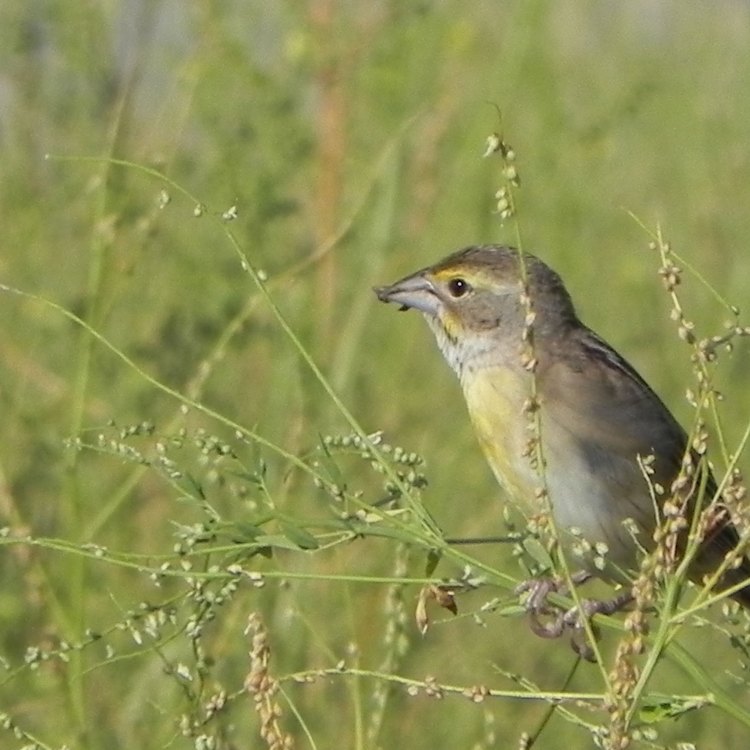
A Songbird of the Prairies: The Fascinating Dickcissel
Disclaimer: The content provided is for informational purposes only. We cannot guarantee the accuracy of the information on this page 100%. All information provided here may change without prior notice.


